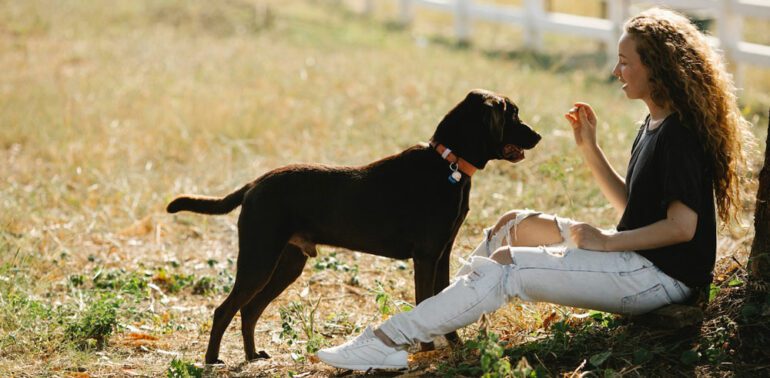The options can be overwhelming when choosing the best training collar for your dog.
As a dedicated dog owner who has spent countless hours researching and testing different training methods, I understand the importance of finding a suitable collar to effectively communicate with and guide your furry companion.
The perfect training collar should balance safety, comfort and effectiveness, ensuring you and your dog have a positive experience during training sessions.
In this guide, I'll share my insights and recommendations based on my own experiences and research.
Whether you’re dealing with a spirited puppy or an older dog needing behavioral adjustments, I can help you navigate the world of training collars to make an informed decision that suits your dog’s needs and training goals.
With the right training collar, you can foster a stronger bond with your four-legged friend while promoting their well-being and obedience. Let’s embark on this journey to find the perfect training collar together.
Types of Dog Training Collars
Listed below is an overview of 11 types of dog training collars based on my research.
- Flat Buckle collar: This basic collar is made of nylon or leather with a buckle for easy attachment. It’s great for everyday use but unsuitable for training as it doesn’t offer any correction.
- Martingale collar: Ideal for dogs that tend to slip out of regular collars. It tightens slightly when the dog pulls, discouraging escape without choking.
- Choke Chain collar: Also known as a slip collar, it tightens when pulled, correcting undesirable behavior. However, this collar can be harsh if not used properly and is not recommended for most dogs.
- Prong/Pinch collar: This collar has blunt metal prongs that pinch the dog’s neck when pulled. It’s considered controversial and should only be used under the guidance of a professional trainer.
- Shock collar (E-collar): Operated remotely, shock collars deliver electric stimulation when a dog misbehaves. They should only be used with extensive training and supervision, not as a first resort.
- Citronella collar: Instead of shock, this collar releases a burst of citronella spray when the dog barks excessively. It’s more humane but may only work for some dogs.
- Ultrasonic collar: Emits a high-pitched sound when the dog barks which is unpleasant for the dog. This collar can be hit or miss, as some dogs are unaffected by the sound.
- Vibration collar: Provides a vibration as a correction. It’s milder than a shock collar and can be a good option for sensitive dogs.
- Remote Training collar: These collars have a remote control that allows you to deliver various corrections like vibration or sound from a distance. They are versatile and can be effective when used correctly.
- Head collar (Halti or Gentle Leader): Designed to guide a dog’s head gently, these collars offer control over pulling and are a humane alternative to choke or prong collars.
- No-Pull Harness: While not a collar, a no-pull harness is worth mentioning. It discourages pulling by redirecting the dog’s motion without causing discomfort.
Choosing the right training collar is a crucial decision that should take into considersation your dog’s size, behavior and training philosophy.
What’s the Best Training Collar for a Dog?
Indeed, it’s essential to consider your dog’s specific needs and training goals when choosing the best training collar. Based on the 11 types of collars mentioned earlier, here are a few recommendations.
To view our dog training collar recommendations, Check On Lets Have Pet.
How Do you Size a Training Collar?
Sizing a training collar is crucial in ensuring your dog’s comfort and safety during training. Here’s how I would go about it:
- Measure Your Dog’s Neck: Use a soft measuring tape or a piece of string to measure the circumference of your dog’s neck. Make sure to measure the widest part of the neck, typically just below the ears and where the collar will sit.
- Add Some Room for Comfort: Once you have the measurement, add a few inches (about 2–-3 inches) to allow for comfortable movement and space for the collar to fit without being too tight. This ensures that the collar won’t choke or harm your dog.
- Check the Collar’s Sizing Chart: Most training collar manufacturers provide charts correlating neck measurements to collar sizes. Consult the manufacturer’s recommendations to select the appropriate size based on your dog’s neck measurement.
- Fit Test: After choosing the collar, it’s essential to do a fit test. Place the collar around your dog’s neck and ensure you can fit two fingers comfortably between the collar and your dog’s skin. It provides a snug fit without being too tight.
- Adjust as Needed: Some training collars, like martingale or prong collars, may have adjustable components. Adjust these properly to fit your dog’s neck comfortably but securely. For remote training collars, ensure the receiver fits snugly without being too tight.
- Regularly Check Fit: Dogs can grow or lose weight, so check the collar’s fit periodically. Make necessary adjustments to ensure it remains comfortable and practical during training.
What Is the Difference Between a Bark Collar and a Training Collar?
Bark collar
A bark collar is explicitly designed to address excessive barking in dogs. It is usually a standalone device that activates in response to the sound or vibration of a dog’s barking. Here are some critical characteristics of bark collars:
- Triggered by Barking: Bark collars activate when they detect the sound of a dog barking or the vibrations caused by the barking. The owner does not typically control them.
- Correction Methods: Bark collars primarily use aversive stimuli to discourage barking. Standard correction methods include static shock, citronella spray, ultrasonic sound or vibrations. The choice of correction varies depending on the model.
- Automatic Operation: Bark collars are automatic and do not require direct input or control from the owner. They are designed to discourage barking when it occurs.
Training collar
A training collar is a more versatile tool for dog training and behavior modification. It can encompass a range of collars, including flat buckle, martingale, prong, remote training collars and others. Here are some critical characteristics of training collars:
- Versatile Use: Training collars serve multiple training purposes, such as teaching commands, leash manners and behavior correction. They can be used for obedience training, leash training and addressing specific behavioral issues.
- Owner-Controlled: Unlike bark collars, training collars are controlled by the owner or trainer. They allow the owner to deliver corrections or reinforcement during training sessions.
- Various Correction Methods: Training collars offer a variety of correction methods, including gentle ones like positive reinforcement (reward-based training) and more aversive techniques like static stimulation (shock) or vibrations. The choice of method depends on the training philosophy and the dog’s specific needs.






